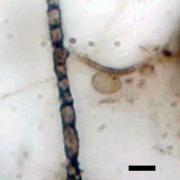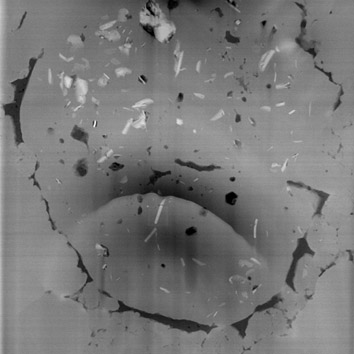The oxygenation of our planet began about 3 billion years ago and changed for ever the chemistry of oceans and atmosphere and stimulated the evolution of life. However, demonstrable fossils of cyanobacteria, the microorganisms that produce oxygen through photosynthesis, are very scarce in rocks older than 1.7 billion years. Most of fossil microorganisms of this age could represent bacteria unable to produce oxygen. After a first major oxygenation event 2.3 billion years ago, oxygen concentrations may have returned to very low levels for about a billion years, possibly due to a lower abundance of these oxygen-producing microorganisms. We show, in an assemblage of microfossils 1.88 billion years old, that a number of species systematically display internal ferruginous nanocrystals. We interpret these crystals as derivatives of intracellular biominerals, which are thus reported for the first time in ancient microfossils. These ferruginous nanocrystals, coupled with the shape of associated cells, suggest that a large fraction of the fossil microorganisms were photosynthetic bacteria that produced oxygen (cyanobacteria) in iron-rich primitive environments.
Before the advent of algae more than 1.2 billon years ago, and the advent of organisms possessing a cell nucleus (eukaryotes) more than 1.7 billion years ago, our planet was dominated by microorganisms with a relatively simple cell structure (bacteria and archaea). Fossil microorganisms older than 1.7 billion years are very difficult to identify biologically due to their simple shape, their small size (several micrometers at most, see photo below), and the poor preservation of their organic “soft parts”. This problem has persisted for more than 60 years for the famous fossil microorganisms (microfossils) of the Gunflint Formation of Canada, aged 1.88 billion years. These represent one of the oldest and best preserved occurrence of microbial fossils and their finding fostered the search for early life on Earth. These microfossils could represent bacteria able to produce oxygen through photosynthesis (cyanobacteria) or non-photosynthetic bacteria that could have metabolized iron or organic matter, for example.

Optical microscope photo of different microfossils in cherts (rocks made of quartz: SiO2) from Gunflint (Canada). Scale bar 5 micrometer long (= 5 thousandths of a millimeter).
© Kevin Lepot
These microfossils of the Gunfint Formation have been studied at the nanometric scale by a team of researchers from the University of Lille – CNRS (Laboratoire d’océanologie et de géosciences ; Unité matériaux et transformations ; Institut d'électronique, de microélectronique et de nanotechnologie), and of the University of Liège (Département de Géologie), in collaboration with the universities of Harvard, Antwerp, and Saskatchewan, thanks to research grants from France (ANR M6fossils, CNRS-INSU et Conseil Régional des Hauts-de-France), Belgium (FNRS et BELSPO IAP PLANET TOPERS), the European Union (ERC StG ELiTE, European Regional Development Fund, et FP7-ESMI), and the USA (NASA Astrobiology Institute).
The results, published in Nature Communications on the 23rd of March 2017, allowed the discrimination of distinct species (or types) of fossils by showing the preservation of cellular structures that conventional microscopy could not distinguish clearly. Analyses of the structure, distribution and chemistry of crystals at the nanoscale showed that ferruginous nanocrystals (image below) occurred systematically inside fossil cells of specific species, whereas other species are deprived of such nanocrystals.

STEM microscopy image of microfossil of the type Huroniospora. Organic matter (in black) is preserved under the shape of a thick cell-wall impregnated in quartz crystals (in grey). The fossil cell is also filled with ferruginous nanocrystals (in white). Diameter of the fossil: about 7 micrometers. Size of ferruginous crystals: 50 à 500 nanometres (millionths of millimeters).
© Kevin Lepot
The ferruginous nanocrystals are interpreted as derivatives of biominerals produced by some species of microorganisms, inside their cells and during their life 1.88 billion years ago. Iron mineralizing microorganisms have been studied extensively during the last 20 years for their environmental impact; among these, only photosynthetic bacteria that produce oxygen combine the ability to produce ferruginous biominerals inside cells and a morphology compatible with the observed microfossils.
The observed iron-rich nanocrystals support the hypothesis that some Gunflint microfossils produced oxygen through photosynthesis. Moreover, they were tolerant to ferruginous waters of that time, which are toxic to many microbes. Through photosynthesis, they could have contributed, about 1.9 billion years ago, to the oxygenation of environments and to the formation of the gigantic iron deposits currently exploited in several parts the world.
Source : Nature Communications
DOI: 10.1038/NCOMMS14890
Iron minerals within specific microfossil morphospecies of the 1.88 Ga Gunflint Formation
Kevin Lepot1,2, Ahmed Addad3, Andrew H. Knoll4, Jian Wang5, David Troadec6, Armand Béché7, Emmanuelle J. Javaux2
1 Laboratoire d'Océanologie et de Géosciences, Université de Lille, CNRS UMR8187
2 Laboratoire de Paléobiogéologie, Paléobotanique & Paléopalynologie, UR Geology, Département de Géologie, Université de Liège
3 Unité Matériaux et Transformations, Université de Lille, CNRS UMR8207
4 Department of Organismic and Evolutionary Biology, Harvard University
5 Canadian Light Source Inc., University of Saskatchewan
6 Institut d’Electronique, de Micro-électronique et de Nanotechnologie, Université de Lille, CNRS UMR8520
7 Electron Microscopy for Material Science, University of Antwerp




